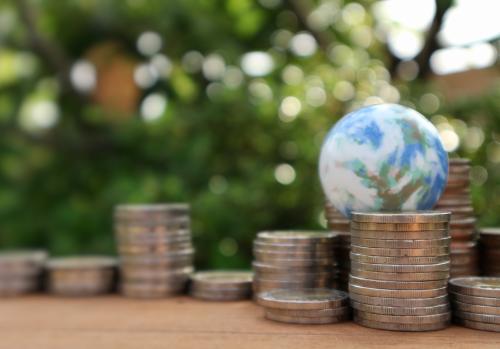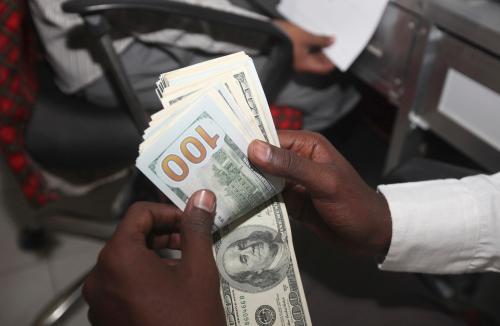Things were looking shaky for Indonesia this time last year. Their exchange rate fell 20 percent from February to April. Their $410 billion of foreign debt swelled as their currency plunged. The collapse in tourism and fall in commodity prices meant the foreign exchange they normally used to finance those debts was evaporating. The sudden stop in capital flows meant refinancing the $44 billion of debt that was due in the coming months might not be possible.
Indonesia needed international help. Where they sought that help was typical of many developing countries, but it also reveals why linking debt forgiveness to investments in Sustainable Development Goals (SDGs) projects might not be as effective as some think. Luckily, there is a better way to use debt markets to support the SDGs.
Indonesia’s first port of call when it faced financial difficulties was to seek bilateral support from its friends: a standby loan from Australia, the repo facility with the New York Federal Reserve, and an expansion (or confirmation) of existing bilateral currency swap lines with Australia, China, Japan, Korea, Malaysia, and Thailand.
Developing countries will give preference to international finance that comes without strings attached over finance that does.
Regionally, Indonesia went to the Asian Development Bank (ADB) and the Asian Infrastructure Investment Bank (AIIB). Globally, it went to the World Bank and the United Nations COVID-19 Response and Recovery Fund. With these supports in place, the government termed-out its debt by switching short-term debt for longer-term debt and bolstered its foreign exchange reserves by selling long-term U.S.-dollar denominated bonds.
These supports helped stabilize the Indonesian currency and financial system by boosting investor confidence in Indonesia’s ability to finance its debts. But what’s more interesting is where Indonesia didn’t go for help. It didn’t go to the International Monetary Fund, suggesting that the stigma of the IMF is alive and well in Asia, and it didn’t go to the Chiang Mai Initiative Multilateralization (CMIM), suggesting that the so-called regional alternative to the IMF remains anything but.
Indonesia’s approach is not unusual according to recent data from the ADB. More than one-third of the external support received by Asia’s developing countries during COVID-19 came from the ADB. More than 20 percent came from bilateral loans and foreign aid. Around 18 percent came from the World Bank while only 9 percent of international support came from the IMF, only slightly more than what came from the China-dominated AIIB (at 6 percent).
While it is unclear how much support came from bilateral currency swap lines, these findings highlight two things.
First, they show just how crucial these international institutions have been during the pandemic. The funds sought from global, regional, and bilateral institutions amount to 40 percent of the amount developing countries spent during COVID-19 through fiscal and monetary policies. Less funding from these institutions would have meant weaker responses to COVID-19.
Second, the findings reveal that developing countries will give preference to international finance that comes without strings attached over finance that does. Developing countries have options. The facilities that have little to no conditionality—like bilateral loans and development bank supports—were strongly preferred during COVID-19 over those that have more conditionality. For instance, the IMF and the institutions and mechanisms that link to it, such as the CMIM and the G-20’s Debt Service Suspension Initiative, or DSSI, require countries to have at least requested IMF assistance.
The preference for funding with fewer strings attached might be obvious to some, but it highlights a critical problem with the idea of linking debt forgiveness to investments that help achieve the SDGs: Developing countries that have other options available to them won’t sign-up to conditional debt forgiveness agreements if they can get a better deal elsewhere. This is particularly the case in Asia where bitter memories of the IMF’s conditionality during the Asian financial crisis—described as a failure by the IMF’s Independent Evaluation Office—could well make conditional international support politically untenable even when those conditions align with the sustainability objectives of Asian policymakers.
After all, debt forgiveness is not the only way to increase fiscal space. If an economy’s stock of debt is reaching its limit, that economy could seek to reduce its stock of debt through debt forgiveness or seek to increase their debt limit by bolstering market confidence in their ability to finance their debts. Bilateral currency swap lines, access to low-conditionality financing facilities with regional and global financial institutions, terming-out debt, and swapping foreign-denominated debt for local currency debt all act to boost that confidence and increase fiscal space.
Nor is debt forgiveness without risk. Many developing countries have shunned the DSSI, fearing that debt forgiveness could compromise their access to financial markets and damage capital flows through a negative backlash from private sector creditors. The widening of bond spreads in the early days after countries signed on to the DSSI did little to ease those fears. Making debt forgiveness conditional on SDG spending could make participating in these programs even less attractive.
To be sure, the alternatives to debt forgiveness vary widely from country to country. Some have many options, others have few depending on which international institutions that country is a member of, how much that country can borrow from those institutions, and the extent to which that country has access to bilateral swap lines. Countries with fewer alternatives may well have little choice but to sign on to debt forgiveness programs while countries with many options are more likely to shop around.
There is a better way to use global debt markets to support a green and inclusive recovery after COVID-19: supporting sustainable finance. Research shows that borrowers who perform well on environmental, social, and governance indicators are 50 percent less likely to default on their loans. Offering lower interest rates to these borrowers means lower and better-priced risks on bank balance sheets, achieving the twin goals of financial stability and sustainability.
Global and domestic regulation and supervisory frameworks, however, constrain this lending. These frameworks, including global capital rules, do not distinguish between sustainable and non-sustainable lending in regulations around the quality of bank capital, despite the lower risk profile of the former. If green loans (and securities underpinned by green loans) are safer than other loans, this should be reflected in global capital rules and domestic regulatory frameworks. The failure to do so weakens the incentives of banks to incorporate sustainability into their lending and prevents the proper pricing of risk.
The world’s health and economic recovery from COVID-19 will hinge to a significant extent on the fiscal space of developing countries. While debt forgiveness will be necessary for some, making that forgiveness conditional on SDG investments risks achieving less of both.
The Brookings Institution is committed to quality, independence, and impact.
We are supported by a diverse array of funders. In line with our values and policies, each Brookings publication represents the sole views of its author(s).







Commentary
The problem with linking debt forgiveness to the Sustainable Development Goals
March 10, 2021